Google Pixel 3a Visits Geekbench, Tipped to Pack Snapdragon 670 SoC
from NDTV Gadgets - Latest http://bit.ly/2UOTKLN

Do you look back fondly at games like Duck Hunt, Lethal Enforcers, House of the Dead, Virtua Cop, and other light gun games for classic systems? Unfortunately, while there are plenty of ways to go back and play retro games on devices like a Raspberry Pi, there’s no way to go back and play light gun games on modern TVs, as they require tube TVs in order to function.
However, Sinden Technology is looking to bring light gun gaming to the 21st century with a new piece of technology that promises to make the games work on modern displays. Not only does it allow retro games to work, but it even promises to add some new technology that’ll make the experience even better than it was back in the day.
Currently, the folks at Sinden have a working prototype for its light gun, which means backers of the Kickstarter will actually be able to get their hands on one fairly soon and start playing games.
However, according to the creator, the actual light gun is “the first part of a larger ambitious project which is to restore the Lightgun genre by removing the technological blockers.” Not only is it a new piece of hardware, but it’s also a completely new technology.
The gun promises to interact directly with the TV without any additional hardware (like the Wii, which requires a sensor bar). It promises to remain accurate even as you move around the room thanks to a new form of tracking.
The prototype is 3D printed and features a high-speed camera, a CPU, USB interface, a trigger, four assignable action buttons, and a pump action reload feature. The final design will have an additional four assignable buttons, bringing the total to eight.
At this time, there are drivers for Windows and Linux (which includes the Raspberry Pi for any Retro Pi users out there). The creator is working on other OSes, but time will tell whether those come to fruition.
For the time being, the device will be used to play retro light gun games, but the creator says his “long term goal is to bring back the Lightgun to the masses and get brand new Lightgun games made.”
Right now, backers of the project can get a light gun for about $103 (£80). If you want to get one with the additional recoil feature, the price is around $168 (£130). The creator plans to ship the light guns in October 2019.
If you love retro games, check out this list of crazy valuable games for the NES.
Read the full article: Sinden is Bringing Light Gun Games Back to Modern TVs

Spotify now boasts 100 million paid subscribers. This makes Spotify the first music streaming service to hit the milestone. It also means Spotify retains its crown as the biggest streaming music service in the world, despite competition from Apple Music.
Spotify first launched in 2008, making its debut in its native Sweden. It then launched in the UK and across Europe, before crossing the pond to the US in 2011. Spotify offers both free and paid tiers, with the free tier supported by advertising.
Artists have a love/hate relationship with Spotify. On the one hand, Spotify has helped stop people from pirating music. However, there have been complaints about the amount of money the company pays artists, leading to Taylor Swift publicly dissing Spotify.
None of which has prevented Spotify from growing year on year.
Spotify recently reported its earnings for Q1 2019, and it’s a mixed bag of good, bad, and ugly results. However, the headline is that Spotify now boasts 100 million paid subscribers, which represents a year-on-year increase of 32 percent.
This number is dwarfed by the 217 monthly active users (MAUs) Spotify now boasts. Which means well over half of the people using Spotify are opting to make use of the free tier rather than pay up. The number of MAUs is up 26 percent on the same time last year.
Spotify’s paid subscribers:
Mar 2019: 100 million
May 2018: 75 million
July 2017: 60 million
Mar 2017: 50 million
Sep 2016: 40 million
Jun 2015: 20 million
May 2014: 10 million
Dec 2012: 5 million
Mar 2011: 1 million
Jul 2010: 500,000
May 2008: 0— Jon Erlichman (@JonErlichman) April 29, 2019
Despite this positive growth in both the number of monthly active users and paid subscribers, Spotify is still losing money. For the quarter covering January to March 2019, Spotify posted a loss of $158.3 million, slightly down on last year.
As a comparison, Apple Music has around 50 million paid subscribers, and no free tier. However, Apple Music only arrived on the scene in 2015, so the company has gained ground on the market leader in an impressively short space of time.
Spotify has big plans for the future. For starters, it’s busy acquiring companies specializing in podcasts, including Gimlet, Anchor, and Parcast. Podcasting is really hitting its stride as a medium, and Spotify is right to be investing heavily.
The company is also continuing to push into new territories. In February 2019, Spotify launched in India with a ridiculously cheap plan. And the company is now boasting it has picked up more then 2 million users since launch. And that’s sure to increase.
Image Credit: Sunil Soundarapandian/Flickr
Read the full article: Spotify Now Has 100 Million Paid Subscribers
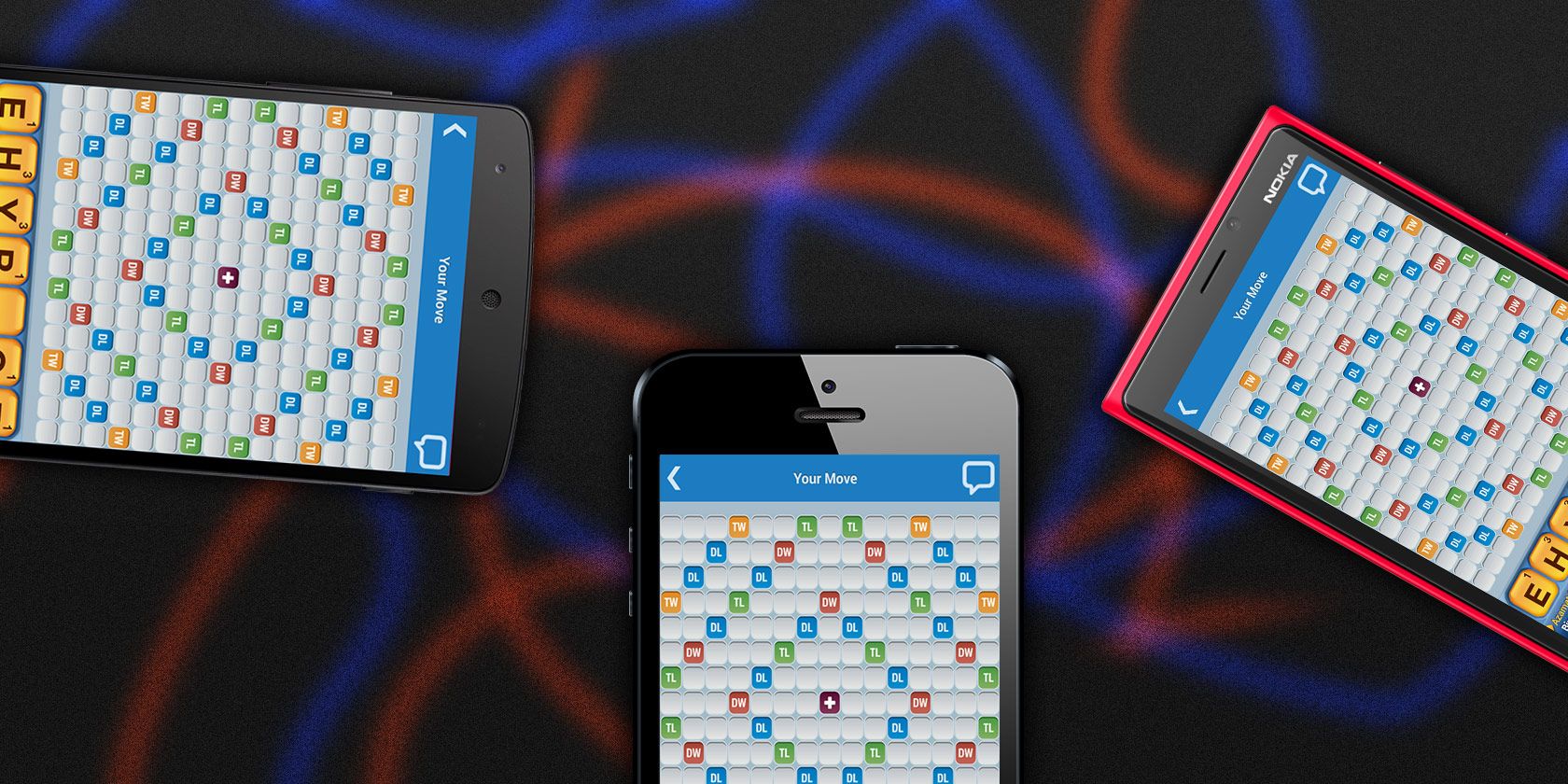
If you and your friends can’t agree on whether Android or iOS is better for mobile gaming, don’t worry, as there’s no need to choose between them. That’s because these games can be played on both iOS and Android.
OK, so your one friend still using Windows Phone might feel left out, but these awesome cross-platform mobile multiplayer games deserve a place on your smartphone, no matter what operating system you use.
Spaceteam is the one game on this list that requires all your friends to be in the same physical space.
In Spaceteam, you and your friends are the crew of a spaceship and everything’s going wrong. To stay on course, you’ll need to work together by shouting different made-up space commands to each other. The speed and the chaos ramp up and up, until you all inevitably crash and die, only to be awarded medals posthumously. But it was fun while it lasted.
Download: Spaceteam for iOS | Android (Free, in-app purchases available)
The sequel to the acclaimed Words With Friends is more like an update.
Of course, there’s the regular Words With Friends experience that you’re used to, where you and a friend or online stranger take turns trying to rack up points on a board by spelling out words Scrabble-style.
However, while Words With Friends 2 keeps everything you loved about the first version, it adds a few new modes for a different sort of challenge.
Lightning Round pits two teams of five against each other to see who can come up with a certain score in the fastest amount of time. Solo Challenge lets you play against challenging bots to win a virtual prize. Finally, Words With Friends Live drops in with HQ Trivia-style questions during your game, every day at a certain time.
Download: Words With Friends 2 for iOS | Android (Free, in-app purchases available)
A MOBA (Multiplayer Online Battle Arena) similar to League of Legends, Vainglory lets you team up in 5v5 or 3v3 modes against other players or bots.
Choose from one of over 40 heroes and go head to head against another team to destroy their Vain crystal before they destroy yours. Travel through the jungle destroying enemy turrets and minions, using your special powers and working together as a team.
Download: Vainglory for iOS | Android (Free, in-app purchases available)
The award-winning board game now fits in your pocket.
Ticket to Ride makes you and your friends railroad barons, competing to be the first ones to link up the country by train. The graphics stay true to the original board game, down to the virtual train cards you draw and put in your hand.
You can play in Pass-And-Play mode, which lets you take your turn and pass it to your friends in front of you. You can also play in local, online or solo modes. Each game takes 15-20 minutes to complete, making it perfect for passing the time on a real-life train trip.
Download: Ticket to Ride for iOS | Android ($4.99, in-app purchases available)
Originally referred to as the Pocket Edition, the mobile version of the best-selling game is almost identical to the PC version. The only major differences being that you can’t connect third-party mods or use third-party servers. Also, typically, any update that comes out for Minecraft won’t come out for the mobile versions until later date.
That being said, the mobile version is a wonderful way to experience Minecraft on the go.
Playing Minecraft alone, however, is no fun. No matter the platform, Minecraft was made for socializing, and its cross-compatibility lets you play with your friends.
Download: Minecraft for iOS | Android ($6.99, in-app purchases available)
Real-life trading card games are fun, but online trading card games let you do things like summon demons and blow up your booster packs.
Hearthstone, developed by Blizzard and set in the world of Warcraft, is a strategy game that lets you collect cards, build decks, and duel your friends. It’s free to play, but you can always buy new card parks to give yourself that extra edge.
With periodic expansions, tournaments and challenges, there’s always a reason to get back into Hearthstone. Play your friends in the Arena or battle strangers to increase your Rank.
And if you’re struggling to win, check out our complete guide to Hearthstone.
Download: Hearthstone for iOS | Android (Free, in-app purchases available)
When it debuted, Pokémon Go smashed the glass ceiling for AR (Augmented Reality) gaming, bringing pocket monsters into the real world. You and your friends can take your phones, no matter the platform, and go out into the world and explore.
Download: Pokémon Go for iOS | Android (Free, in-app purchases available)
The world’s most popular battle royale game is available on pretty much any platform you can think of, including iOS and Android. While playing on your smartphone might not sound great, Fortnite on mobile is well worth playing.
First of all, unlike PlayStation 4, XBox One or Nintendo Switch, whose online platforms require a subscription, playing Fortnite on your phone is free.
Secondly, the mobile version has some features that make moving around a little easier. You can automatically pick up whatever you walk over and open doors that are in front of you.
And finally, now that you can play anywhere, you can dab on the bus.
Download: Fortnite for iOS | Android (Free, in-app purchases available)
Get in a quick nine holes before lunch with this simple-but-fun golfing game.
While Single Player mode is fun on its own, Stickman Golf offers two different multiplayer modes. You can either compete to see how fast you can play each hole in Race Mode, or take turns in the Turn Based mode. Also, you can play locally or online.
Download: Super Stickman Golf 3 for iOS | Android (Free, in-app purchases available)
Letterpress is similar to Words With Friends, but with a much simpler premise and a beautiful aesthetic. You play one opponent, and your goal is to cover the entire tile board in your color (which is always blue). On each turn you spell out a word, and every letter you take turns your color. Your opponent can do the same, and can even take tiles back.
You can “protect” tiles by surrounding them with tiles of your color, and you and your opponent go back and forth until one of you has conquered the entire board.
The premise is simple, but the strategy involved makes Letterpress a fun, challenging game that’s perfect for playing on mobile, whatever your platform.
Download: Letterpress for iOS | Android (Free, in-app purchases available)
So there we have it, a selection of the best cross-platform multiplayer games to play on your mobile devices. We can’t guarantee you’ll be any good at these games, but we can guarantee you’ll have fun playing them.
Is one of your friends always beating you? Maybe they’re playing on an iPad Pro while you’re stuck using an old Android phone. In which case you should read our guide to the best device for mobile gaming.
Read the full article: 10 Awesome Cross-Platform Mobile Multiplayer Games to Play With Friends
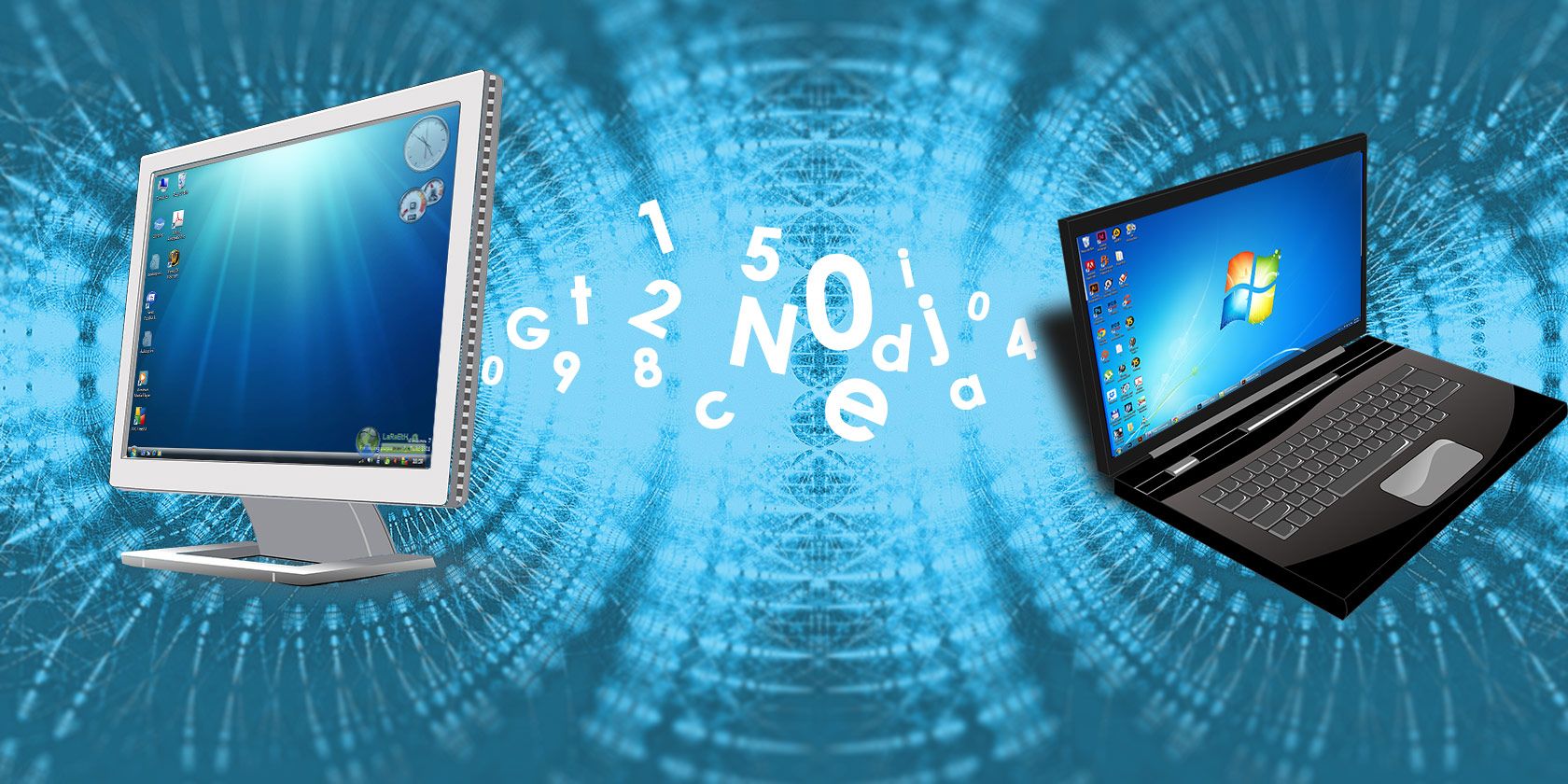
The phone rings. You pick it up. It’s Aunty Ethel again. “Just nip around again, young Gavin, the computer is doing that Thing.” Cursing, you look to the sky, wondering if there is an easier way to help. Other than bumping your poor Aunt off. Eureka! You can use a remote desktop connection to fix the computer from the comfort of your own chair.
Remote desktop connections don’t always work how you want. Here are several tips on fixing remote desktop issues so you can continue your role as the family system admin, no matter where you are.
The inability to connect to the remote computer is a common problem.
First, check your network settings. Do both computers have a network connection? It is always the easiest connection issues that sneak under the radar! If both computers have a network connection, you can move on. The Windows Remote Desktop Connection requires either an IP address or a name for the console you are attempting to view.
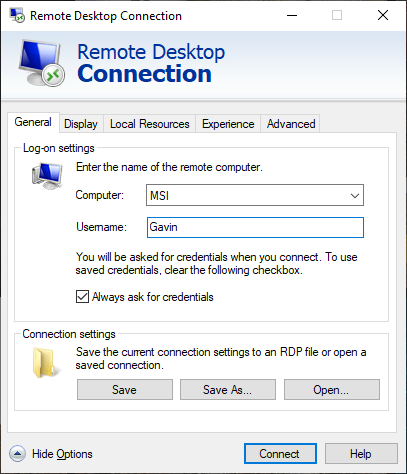
Make sure you have the correct IP address for the remote computer. On the remote computer, you can browse to whatismyip and copy down the address. If you are not with the remote computer, you must ask someone at the location to do this for you, then send you the IP address.
Similarly, to find out the computer name of the remote device, head to Start Menu > Control Panel > System, and view the computer name and workgroup.
You might find that remote connections are disabled on the terminal you are trying to reach. You can alter this setting on the same System page as above. To the right of the computer name and workgroup, select Change Settings to open the System Properties menu. Select the Remote tab.

Windows 10 offers the same Remote Desktop Connection options as older Windows versions. Under Remote Desktop, there are two options:
Once you allow remote connections, you also have the option of only accepting remote connections using Network Level Authentication. Network Level Authentication is “an authentication method that completes user authentication before you establish a full Remote Desktop connection and the logon screen appears.”
It provides an additional layer of security from malicious software and users while using fewer resources in the process.
However, if you struggle to create a remote desktop connection after switching Network Level Authentication on, try turning it off.
You can check if your version of Remote Desktop supports Network Level Authentication by clicking the top-left of the dialog box, as seen below, and select About.

Windows 10 Home users struggle with Remote Desktop. Why? Because Windows 10 Home doesn’t support incoming connections. At least, not natively. Windows 10 Home users can make an outgoing Remote Desktop connection to a different computer (not running Windows 10 Home!), but not vice versa. Thankfully, there’s a simple, software-based fix that works around the issue: the RDP Wrapper Library.
(Alternatively, check out the 7 best screen sharing and remote desktop tools!)
The RDP Wrapper Library uses the existing Windows Terminal Service and adds new Windows Firewall rules to allow a remote desktop connection. The RDP Wrapper Library also provides an interface to manage remote desktop connections through (as Windows 10 Home doesn’t have an integrated solution.
Here’s how you allow remote desktop connections on Windows 10 Home using RDP Wrapper Library:
Confused? Check out the following video. It will guide you through the tricky bits of the installation, as well as how to set up your Windows 10 Home RDP Wrapper Library remote connection.
You can use Remote Desktop Connection to copy text from one terminal to your own. If the copy text feature isn’t working, you need to enable the Clipboard redirect function so you can use it on the remote computer.
Open the Remote Desktop Connection dialog box by typing “remote” in your Start menu search bar, then selecting the best match. Select Show Options. Head to the Local Resources tab. Under Local devices and resources, put a check in the Clipboard box. The option should be turned on by default.
Incorrect window size is another common Remote Desktop Connection issue. When you create the remote desktop connection, the window is too large, too small, or doesn’t correlate to the settings you input.
You have two potential fixes here.
First, you can force the Remote Desktop connection to use a specific size via the Run function. Hit Windows key + R, then input:
mstsc.exe /h:X /w:X
Where “X” is the height and width of the Remote Desktop viewing window you desire. Remote Desktop will remember your settings for future remote viewing settings.
The Remote Desktop Connection client has a handy screen resolution slider that scrolls from 640×480 up to Full Screen for your screen. Make sure to set the slider to Full Screen if you want a full-screen remote connection for each connection.

At times, Windows Remote Desktop Connection finds your login details confusing. There is also the chance the login details for your system or the remote system are different from your last remote connection. You can remove and replace your existing credentials to try and fix the issue.
In the Remote Desktop Connection client, head to the Advanced tab. Select Settings, then make sure Automatically detect RD Gateway server settings is selected.
If you regularly connect to several different servers or clients, saving a custom configuration for each Remote Desktop will save time in the future. You can set the optimum width, height, and color settings for each server or terminal.
Open the Remote Desktop Connection dialog, then select Show Options. You will now see the Connection settings options. Select Save As, specify your save location, then select Save to create a custom Remote Desktop Connection file (.RDP).
Now, browse to the Remote Desktop Connection configuration file. You can edit the configuration file using a text editor, such as Notepad or Notepad++. Right-click the configuration file and select Open with…, then select your text editor.

The first four lines show your remote connection screen size options (plus whether multi-monitor mode is available). You can edit the screen mode to set whether the remote window session appears full screen. For instance, “id:i:2” sets full screen, whereas “id:i:1” sets the remote connection to appear in a window.
If you set the screen mode to “2” for full screen, the desktopwidth and desktopheight automatically match the screen size of the host client. However, if you are using screen mode “1,” you can use the desktopwidth and desktopheight settings to set a specific window size.
After you confirm your settings, add the following string to the end of the file:
smart sizing:i:1
Smart sizing allows you to dynamically alter your screen settings without messing around with configuration files while the Remote Desktop connection is active. However, you must add the string for each custom configuration you create.
If you want to customize your remote desktop configuration file further, check out Donkz Remote Desktop file setting overview.
You can boost your Remote Desktop Connection productivity using a handful of keyboard shortcuts. These shortcuts are designed to work when you access Remote Desktop using the Run dialog.
You can use the following Remote Desktop shortcuts once your Remote Desktop connection is live:
You can now connect to dear Aunty Ethel’s computer from the comfort of your own home. You are saving yourself time and effort, while hopefully lining you up for another sensational hand-knitted jumper.
Of course, remote connections are not always from a Windows computer to another Windows computer. Here is how you establish remote desktop access to Ubuntu from Windows, and here’s how to access Windows directly from your Mac.
Read the full article: 8 Tips for Fixing Remote Desktop Connection and Screen Issues
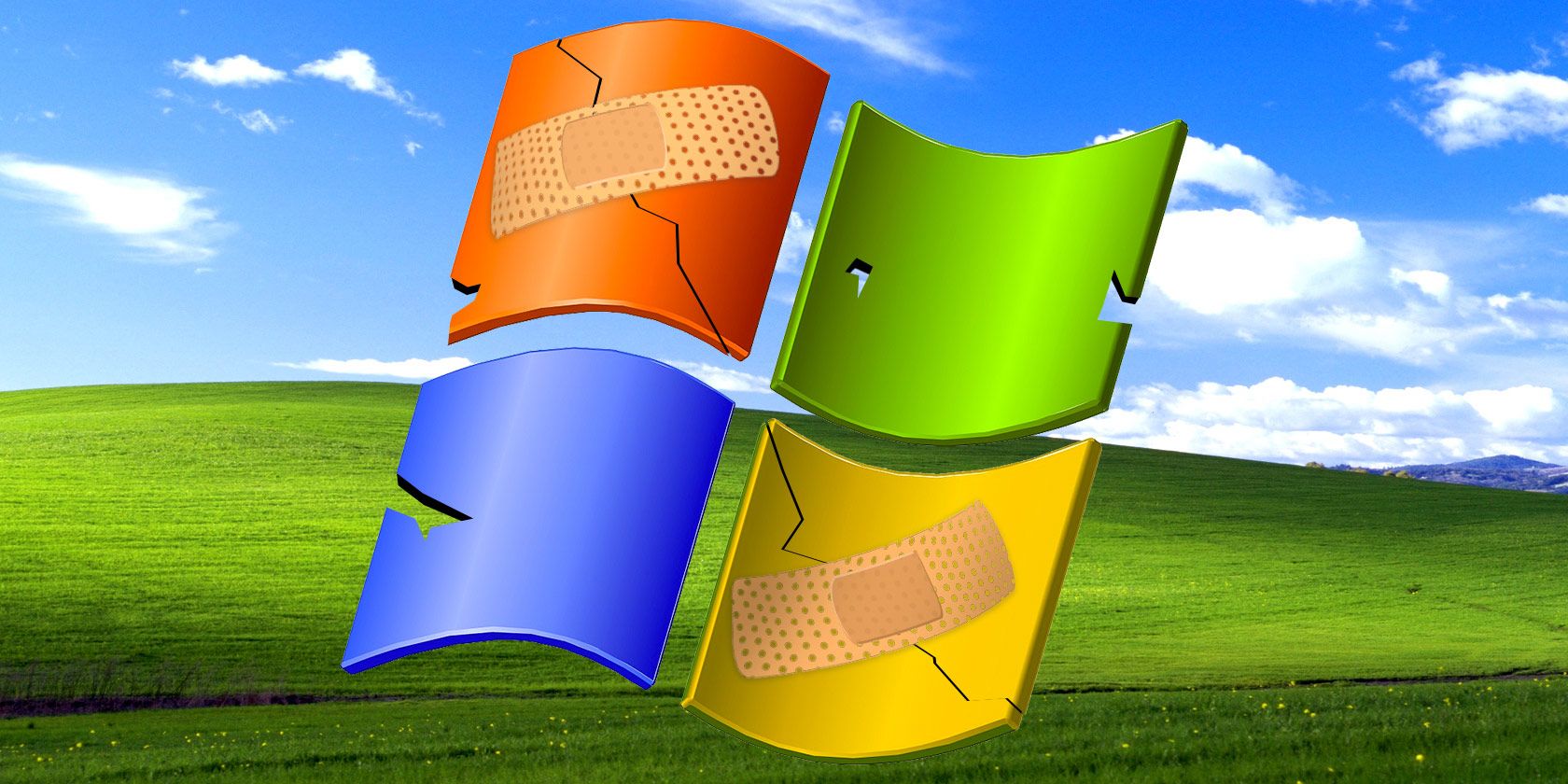
A small percentage of people still use Windows XP, even though support for it ended all the way back in 2014. While you should make every effort to jump from this ancient Windows version as soon as you can, you might wonder which web browsers for Windows XP still work.
Even when Microsoft stopped supporting Windows XP, most popular software continued to support it for some time. That’s no longer the case, as few modern browsers for Windows XP exist now. Let’s take a look at every major web browser to see what the best browser for Windows XP users is.

The most recent version of Internet Explorer available on Windows XP is Internet Explorer 8. IE 8 is wildly outdated, and Microsoft hasn’t supported it since the end of Windows XP’s life.
Not only is IE 8 already an outdated browser without modern features and performance, but it hasn’t received any security patches since April 2014 either. Even if you have to use Windows XP for some reason, you shouldn’t use Internet Explorer anymore.
All sorts of modern websites will let you know that they won’t work properly or at all with IE 8. And of course, Microsoft wants you to upgrade to Windows 10 and use Microsoft Edge.
You should also avoid browsers that use Internet Explorer’s rendering engine. For example, old versions of Maxthon and Avant Browser act as shells around Internet Explorer. They provide a different interface but are vulnerable to the same security bugs as Internet Explorer.

While Chrome supported Windows XP past April 2014, its time has passed as well. In November 2015, Google announced that it would drop support for Windows XP in April 2016. The latest version of Google Chrome that runs on Windows XP is 49. For comparison, the current version for Windows 10 at the time of writing is 73.
Of course, this last version of Chrome will still continue to work. You can’t use any of the newest features of Chrome, however. More importantly, this outdated copy of Chrome won’t receive security updates.
Chrome 49 from April 2016 is better than IE 8 from 2014, but it’s still not safe to use. It’s only a matter of time before attackers blow a huge hole into this version, and Google won’t fix it.

The situation with Firefox is a bit better than Chrome’s, but Firefox’s time on Windows XP has reached its end too. In October 2017, Mozilla announced an end of life date for Firefox on Windows XP of June 2018.
Firefox users on Windows XP got automatically upgraded to the extended support release (ESR) version. This is a slower-moving branch of Firefox that waits longer to add new features than the normal branch.
Thus, Firefox 52.9.0esr is the final edition of Firefox to hit Windows XP. It won’t see any future updates, including security patches. Again, using an XP browser that was last updated in June 2018 is better than one last patched in April 2016, but both are insecure.

While Opera doesn’t enjoy as big of a market share as Chrome or Firefox, it provides a great alternative to Chrome. It’s available on Windows XP, but is it still supported?
The latest update from the Opera team came in August 2016. This confirms that Opera 36 is the final version of the browser available for Windows XP (the current version is 58 as of this writing). Since Opera is now based on Chrome, Opera 36 conforms to Chrome 49.
A few years ago, Opera claimed that it would still update XP users with security patches. The announcement explained that the team added the security patches from Opera 37 back into Opera 36. However, years later, there’s no further information confirming that this is still the case.
Because of this, we recommend that you avoid Opera as well. Its latest version is years old and there’s no sign that it still gets security patches. It is the only major browser that doesn’t show an error message when you check for updates, though.
Either way, you won’t be able to enjoy the coolest Opera features on Windows XP.
We’ve covered the major browsers, but what about lesser-known options that might support Windows XP?
Though it might seem obvious, for completion we should mention two silly-sounding choices. First, though Safari was once available for Windows, Apple discontinued it long ago. If you still somehow have Safari installed on Windows XP, you shouldn’t use it as it’s extremely outdated and insecure.
Second, Microsoft’s replacement for Internet Explorer, Microsoft Edge, is only available on Windows 10. There’s no way to try Edge on Windows XP.
Most alternative browsers have dropped support for Windows XP as well. Pale Moon, a Firefox fork, doesn’t support XP on its latest version. Slimjet, a lesser-known but speedy browser, currently offers version 22 for modern platforms but only supports version 10 for XP users. Vivaldi‘s latest version does not support Windows XP, either.
Maxthon is one other browser for Windows XP that enjoyed support for some time. However, it’s also left XP users behind. The last version of Maxthon to work on Windows XP is 5.1.2, released in September 2017. The current version is 5.2.7.

While you might not be familiar with this Chinese browser, it packs a lot of handy features like a night mode, built-in screenshot tool, and a notebook. However, it’s still unsupported for Windows XP users.
You might find other fringe browsers that still support Windows XP. However, you should avoid them. Little-known browsers with small teams behind them offer less guarantee of security or quality, and it’s nearly impossible to call a browser on an ancient operating system truly secure anyway.
Some people still need an old version of Internet Explorer to connect to certain websites. For example, you might use an internal business website that requires an outdated version of IE. If you must use Internet Explorer for some tasks, don’t use it for everything—open it only to use that specific website and use another browser most of the time.
You can also install the IE Tab Chrome extension, which lets you render pages using IE inside Chrome. Configure IE Tab to always load that old website in an Internet Explorer frame inside your browser and you won’t have to worry about opening and closing IE. However, this tool is not free and still requires using the outdated version of Chrome for Windows XP.
You could also try changing your user agent to trick a site into thinking that you’re using IE. However, this won’t work for sites that actually require you to use Internet Explorer.
Unfortunately, the Windows XP browser scene is essentially dead. You have no real options:
If you really have to use Windows XP, Firefox is the most secure XP browser since it was updated most recently. However, this doesn’t mean it’s a good option. You are not safe running Windows XP because the OS hasn’t received security patches for over five years. Make every effort to upgrade to a modern operating system as soon as you can.
Decided to finally upgrade from XP? Check out the best ways to use your old Windows XP computer and how to revive Windows XP on Windows 10.
Read the full article: Which Browser Is Most Secure on Your Old Windows XP System?

Job searching can be utterly exhausting when you’ve been at it for a long time. There are so many resources devoted to finding the right gig that you can feel inundated by the sheer amount of options. I know I have in the past.
Fortunately, Indeed allows you to search for a career based on your field of work, where you want to live, and the length of time you want to stay at a job. It’s an incredibly useful tool and it cuts back on the stress-induced headaches.
Here are some tips to maximize the website and your own job search.

The very first thing you should do is create an account.
You can browse the job postings on Indeed.com without one. But an account will help you use this service to its fullest extent.

To create an account, click on the Sign In button located on the top right-hand corner of your homepage.
When the new screen appears, click on Not a member? Create an account free.
It will prompt you to fill in your details.

Once you’ve set up your account, the next best tip is to set up your resume.
Your Indeed Resume is a text-only copy of your regular resume that you can attach to job applications. This resume can either be set to public—meaning potential employers can search you—or you can set it on private.
If your resume is set to private, only the companies that you apply to will be able to see your profile.
Hiring managers are busy people, and chances are high that they won’t be searching for you on top of the applications being sent their way. To protect your privacy, feel free to set your resume to private.
The reason you want your resume on Indeed is ease-of-use. You can apply to new positions directly through the website, and when you apply for a job it allows you to attach that resume and your profile specs.
After you attach your resume, the only thing you need to worry about is writing a cover letter. It will save you a lot of time in your search.
Looking for tips on how to write an application? Here are some things you should NOT include in your resume. It will help you avoid common mistakes.

Indeed’s search function is great, and because of its versatility, we’re going to split this section into two parts.
The first way you can use the search function is to scout out an industry’s “health” in a geographic area. This is a good pre-job hunt search to do, especially if you’re:
By typing in what kind of job you’re searching for and where, you will get an overall idea of how many jobs are available in a region. You’ll also see how much competition there will be.
For example: If there are very few jobs located in a highly desirable area, the competition for those jobs will be much fiercer. Think supply and demand.

You can also use the search function to set up job alerts.
A lot of jobs are posted on Indeed. Seriously, there’s a ton. Also, searching through the website takes time.
One of the best ways to maximize your time is to have very specific job alerts sent directly to your email on a daily or weekly basis.
To set up a search alert, type in the type of job you want under what. Then type the location of the job under where.
Once you hit Find Jobs, it will pull up a list of jobs that fit these parameters.
You can then narrow your search further by clicking on Advanced Job Search to the right of the search bar. However, this step is optional.
After you have your search parameters, you can subscribe to the job search under the Get new jobs for this search by email. Simply fill in the email you want the alerts to be sent to. Then click Send me new jobs.
The good thing about this function is that Indeed will send you multiple job postings per email. It works a bit like a newsletter. All you have to do is open up the email, scroll through the postings, then click on the individual links to read more about the positions that interest you.

If you grow tired of receiving these emails, go to the top right-hand corner of your screen where you see your login information. Click on the dropdown menu. Then click on My Subscriptions.
When you do this, your Subscription page will pop up. Here you can either edit your job alerts, change their frequency, pause them, or delete. It’s pretty simple.

Lastly, use the “My Jobs” section to help you organize your applications. You can find the link in the dropdown menu on the top right-hand corner of your screen under My Jobs.
Click on it.
There, you can keep track of saved jobs (AKA the job postings you want to read at a later date), the jobs you’ve applied to, the ones you’re currently interviewing for, or any offers you have on the table.
This organizational tool can become invaluable when you’re applying for a lot of jobs over a longer period of time.
Indeed is a really great service for job hunting, and if you haven’t signed up we fully recommend you do so.
If you’re still not satisfied with it? Well, there are other options out there. Here’s a list of the most effective job search websites to grab your next gig.
Image Credit: Devon/Depositphotos
Read the full article: The Best Way to Search for Jobs Using Indeed
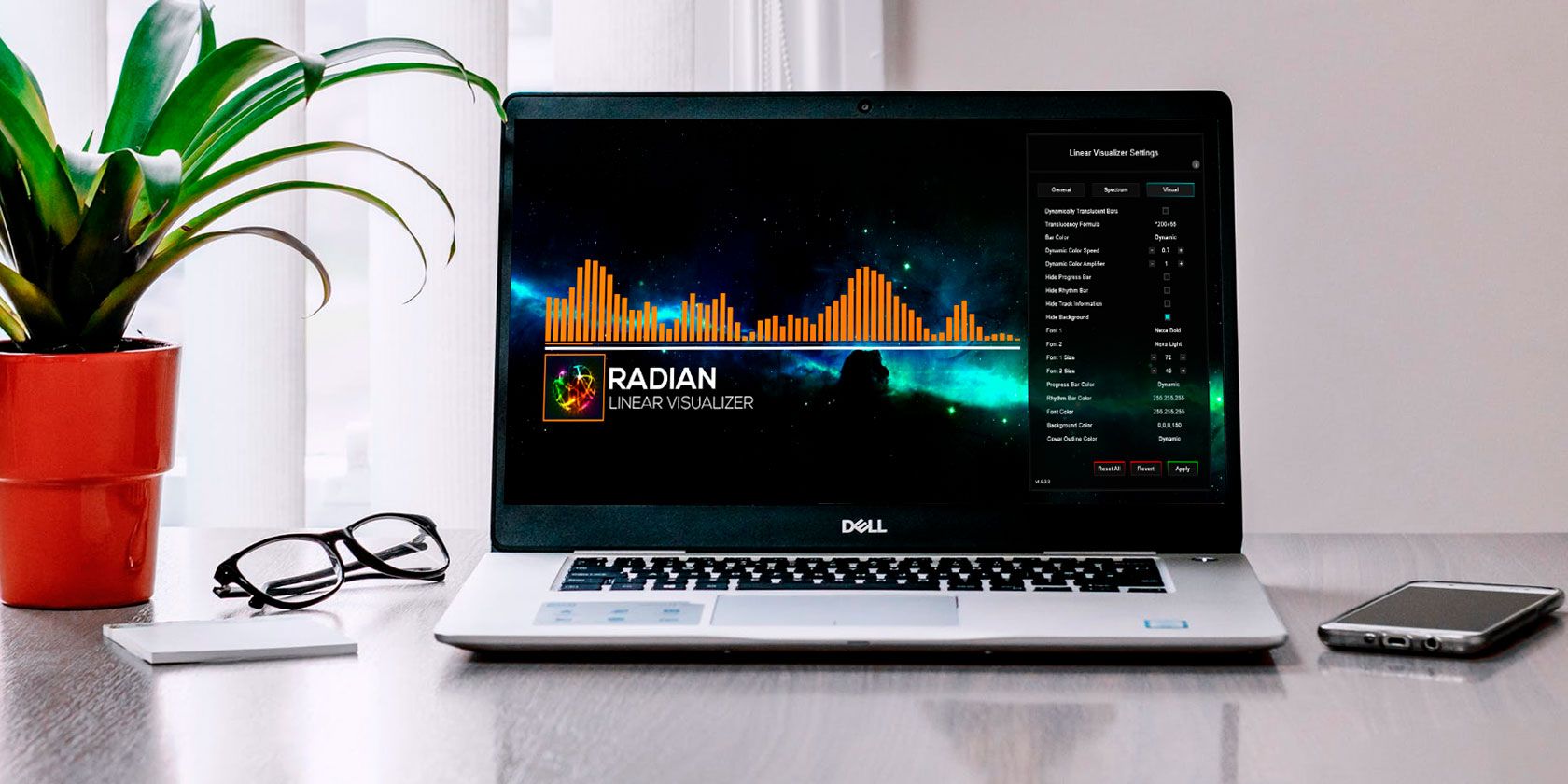
Back in the day, there were very few ways you could control the volume on your Windows computer. However, Windows 10 plays well with smartphones, remote desktop connections, different software fixes, and more. Now there are more ways to control the volume in Windows 10 than ever before.
Here are some of the best ways to control the sound in Windows 10.
Are you looking for something specific?
Hippo Remote Lite is a free iOS app that gives you remote control of your Windows 10 machine. Hippo Remote Lite offers a decent range of functionality for free. You can easily turn your iOS device into a Windows 10 remote control.
Controlling the volume is incredibly easy, too.
See, simple!
Volume control is far from the only thing Hippo Remote Lite does. You can use it as a keyboard or media controller, plus it has support for Boxee, XMBC, and Plex.
Download: Hippo Remote Lite for iOS (Free)
Download: Hippo Remote Lite Server for Windows | macOS | Linux (Free)
Next up, you can use PC Remote for Android to control the sound on your Windows 10 machine. Like Remote Mouse, you install PC Remote to your Android device and a server version to your Windows 10 desktop or laptop. You can then make a connection using Bluetooth or Wi-Fi, controlling the sound of your Windows 10 machine direct from your Android device.
Again, simple!
PC Remote has a bunch of extensive functionality, too. For instance, it has numerous built-in game controller configurations so you can use the PC Remote to control your favorite games. It has integrated file transfers, direct streaming from your Android device camera to your Windows machine, app launch support, specialized keyboards, and much more.
Download: PC Remote for Android | iOS (Free)
Download: PC Remote Server for Windows (Free)
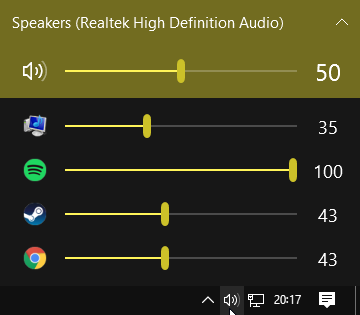
EarTrumpet is a fantastic piece of open source software that gives you vastly more control over Windows 10 volume control. The single best feature of EarTrumpet is the control you have over multiple audio input and outputs for a single system. Instead of having to use the Control Panel or Windows 10 Settings, EarTrumpet creates an individual volume panel for each audio device. Better still, it integrates perfectly with Windows 10, appearing as a native Windows application.
Another ridiculously handy feature is dragging and dropping applications playing audio into different audio devices, plus the control over the volume of those individual apps.
Download: EarTrumpet for Windows (Free)

At times, you may need to restrict the volume range available to Windows 10 users. Greennaturesoft’s Speaker Locker does just that. Speaker Locker has four options:
Best of all, you can combine those volume limits with operation times. For instance, you can set the volume level to remain below 50-percent between 6 AM and midday, but then above 75-percent from midday until 5 PM.
Speaker Locker has administrative passwords so that other users cannot disable it. You can also set Speaker Locker to start with Windows to make sure it is always in place.
Download: Speaker Locker for Windows (Free)
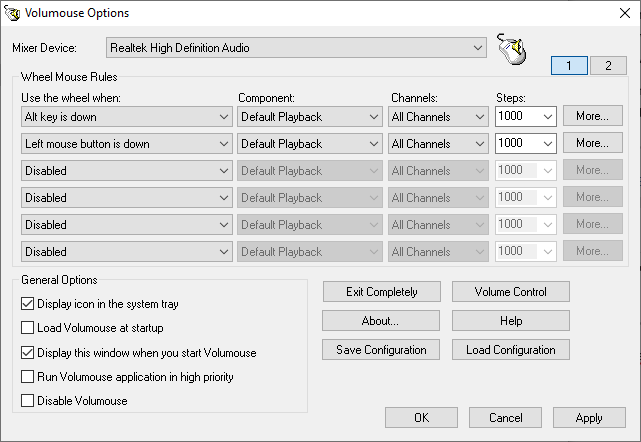
You can control the volume in Windows 10 using your mouse wheel. Nirsoft’s Volumouse lets you use your mouse wheel to control the system volume. Volumouse works best in conjunction with another trigger button, rather than just on its own.
For instance, you can set Volumouse to work only when you hold down right CTRL, or when the mouse cursor is hovering over a certain part of the screen, and so on.
Nirsoft has also developed some plugins that allow you to control the active window or open and close the door of your CD-ROM/DVD with the mouse.
Download: Volumouse for Windows (Free)
3RVX is an open source on-screen display for Windows 10. It features a decent range of customizable on-screen volume controls, tray notifications, and other handy features.
Download: 3RVX for Windows (Free)
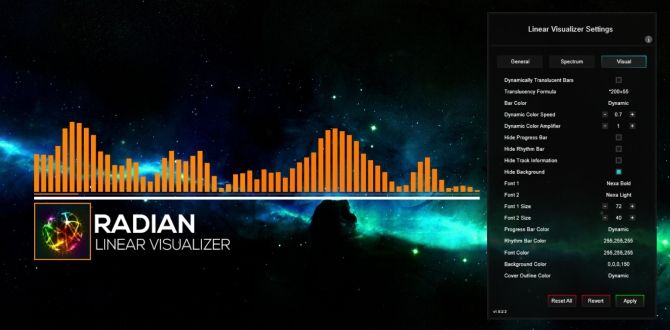
Rainmeter is a free and open source desktop customization tool for Windows. Developers sometimes create incredible Rainmeter skins, including usage meters, audio controls, calendars, applets, and more. I haven’t tinkered with Rainmeter for several years, up to the point of writing this article, so seeing some of the latest custom designs was illuminating.
Other Rainmeter skins come with integrated audio and volume control features. There are a lot of Rainmeter skins out there, and a huge number of plugins and applets too, so you will find something that suits your requirements. Get your Rainmeter desktop customization journey underway with our simple guide to Rainmeter.
Download: Rainmeter for Windows (Free)
AutoHotKey lets you create custom keyboard macros. You can program AutoHotKey to control your Windows 10 volume settings. The following basic script allows you to turn your Windows volume up and down using Windows Key + Page Up and Windows Key + Page Down.
#PgUp::Send {Volume_Up 3}
#PgDn::Send {Volume_Down 3}
But what do you do with the script?
You don’t have to stop there. The AutoHotKey SoundSet document details how to customize the script further. You can add controls to mute, control the bass, treble, bass boost, and many other features.
Download: AutoHotKey for Windows (Free)
Interested in learning more about AutoHotKey? Check out Ian Buckley’s quick AutoHotKey guide for beginners!

Your final Windows 10 volume control option is StrokePlus. StrokesPlus is a free mouse gesture recognition tool. Using StrokesPlus, you can program a custom mouse gesture to control your Windows 10 volume.
StrokesPlus is relatively intuitive. In most cases, you hold down your right-mouse key and draw your gesture. For volume control, you could draw a “U” for volume up, and a “D” for volume down. You can take it further with modifications, extensions, adding in the mouse wheel, and much more.
Download: StrokesPlus for Windows (Free)
You can now control the volume in Windows 10 using your smartphone, using a mouse gesture, with an interactive custom desktop skin, and many more options in-between.
Some people don’t like the Windows 10 volume control. If that sounds like you, why not follow Ben Stegner’s quick guide to getting the old Windows volume control back.
Read the full article: 9 Useful Ways to Control Sound in Windows 10
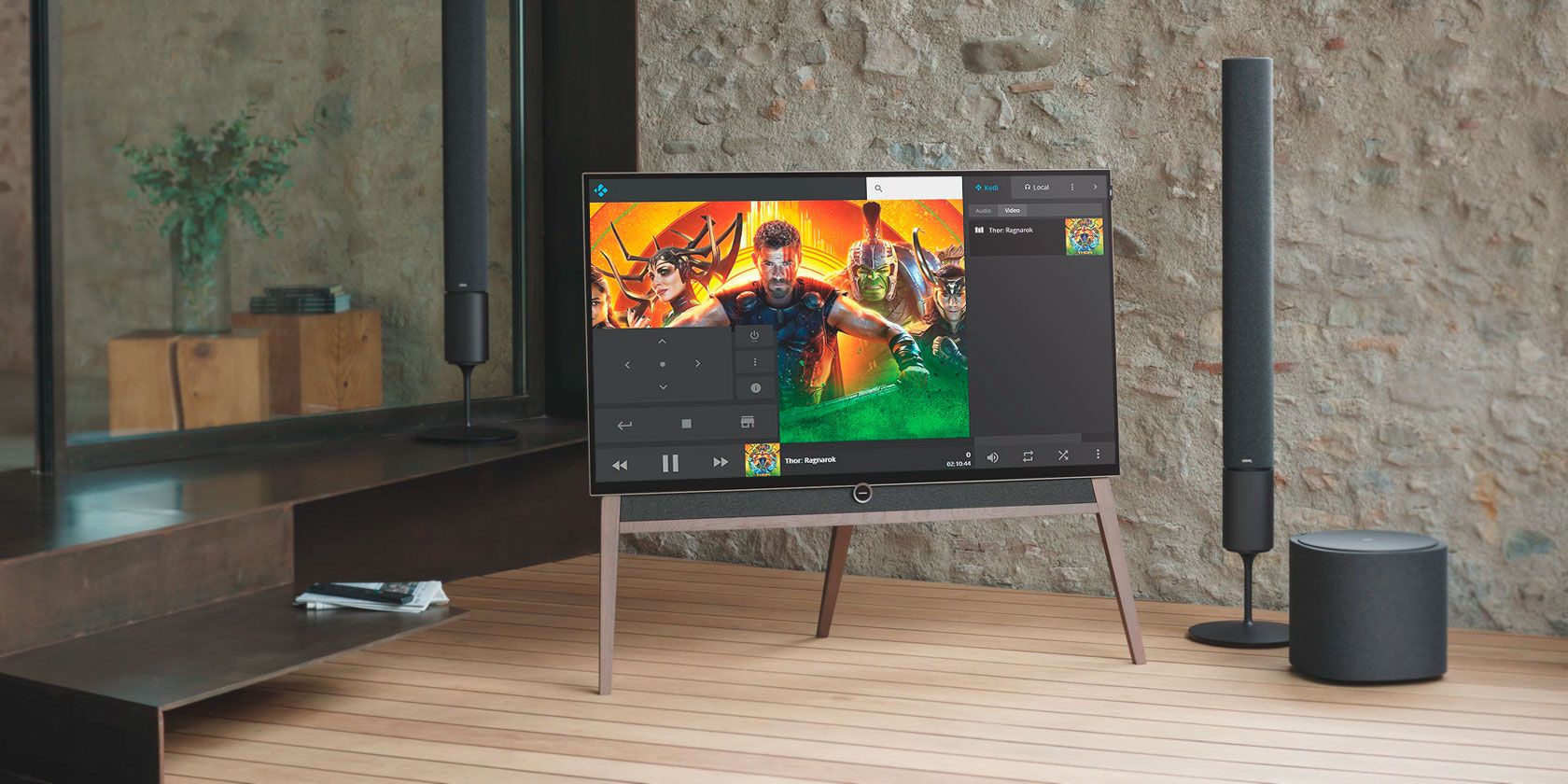
We all know that Kodi is a great open-source media center, but did you know about the Kodi web interface?
This feature is incredibly useful but not widely known. It lets you control your Kodi system, search your files, and manage playlists from any device connected to your network.
And in this article we’ll show you how to use the Kodi web interface to control Kodi.

The web interface is a built-in feature of the Kodi media center. It lets you control your Kodi system, either from the same device or a different one, through your web browser.
This is useful in several ways.
Maybe you’re watching Kodi on your computer and want to be able to control it from your phone. Maybe you have Kodi installed on your PC, and you want to use your keyboard and mouse to set up a playlist. (Most skins, even the best Kodi skins, aren’t designed for keyboard and mouse.) Or maybe you’re having a party and you want all of your friends to be able to add tracks to a playlist. The Kodi web interface allows you to do all of this and more.
The good news is that the web interface called Chorus2 comes pre-installed with Kodi. You don’t need to download any new files as it will be automatically available.
You do need to enable the Kodi web interface though. And here’s how to do that:
Now the web interface is active. If you’re going to be using the web interface with friends, or if you are concerned about security, it’s a good idea to set a username and password. This will prevent anyone from accessing your Kodi system without authorization.
Accessing the Kodi web interface is simple. If you are using the interface on the same device that Kodi is installed on, just open up your web browser. Then type localhost:8080 into the address bar. This will open up the web interface.
To access the Kodi web interface from a different device on your network, you will need to know the IP address of your Kodi device. To find this out, open up Kodi and go to Settings. Then go to System Info and look in the Summary tab. You will see a note with the IP address. It will be something like 192.168.1.4.
Now you know the IP address for your Kodi device, connect your other device to the network through Wi-Fi, then enter the IP address of the Kodi device followed by :8080. For example, you would enter 192.168.1.4:8080 into the address bar of your web browser. Now you’ll see the Kodi web interface and you can control Kodi from your other device.
If you want your friends to be able to access the web interface on their phones, get them to connect to your Wi-Fi then tell them to go to the IP address plus :8080 in their web browser. Now they can control Kodi too.
So now that you know how to install and access the Kodi web interface you might be wondering what you can actually do with it? Here are five things to get you started…

For basic controls using the web interface, you can play/pause, skip forward, and skip backwards using the icons at the bottom of the screen. You can also adjust the volume and activate repeat or shuffle.
But you can also use the web interface as a full remote control. To activate the full remote control, look at the black bar at the bottom of the web interface. You’ll see a small version of the artwork for the movie, TV show, or album you are playing. Click on this artwork.
This brings up a remote control panel. From here you can use the on-screen buttons to activate the 4-way navigation, stop, back, home, information, and context menu buttons.
For other ways to control Kodi remotely, see our list of the best ways to control Kodi from the couch.
One of the most useful features of the Kodi web interface is the ability to add files to a playlist and to reorder the current playlist. The current playlist appears in the right hand panel on the web interface and you can drag and drop files to reorder them, or hit the X on the right hand side to remove them.
Plus there’s a party mode so you and friends can all add songs to a playlist.
You can search through all your different file types using the web interface. At the top of the interface is a grey box with a magnifying glass icon. Just type your search query into this box.
This will pull up all the files that match your query, including movies, TV show episodes, and songs. Then you can click on the artwork to play the file you want.
It’s a bit of a pain to use a keyboard and mouse with Kodi, which makes tasks like cleaning up files’ metadata very slow. But you can do this quickly and easily using the web interface.
Just find the file you want to edit, then click the three dots in the top right of the artwork. Choose Edit. Now you can type in information like the title, artist, year, and so on, and hit Save.

There’s an extra neat feature too. You can play files from your Kodi library right on your phone or other device. When you’re browsing with the Kodi web interface, you can click the three dots in the top right of an album or video file. Then choose Play in browser.
This will stream the file from your Kodi system to your mobile device. It’s great if you want to keep watching a movie in bed.
These are just a few of the features of the web interface. You can also browse your Kodi add-ons, edit your Kodi settings, set up PVR recordings, and more. As is often the case with technology, the best thing to do is have a play around with the Kodi web interface to see what it can do.
Now you know how to enable and use the Kodi web interface, you and your friends can control your Kodi system. You can create and modify playlists, plus edit your files and play files in your browser.
To get even more out of Kodi, you can install add-ons to get new features. To get you started, here are the best Kodi add-ons you didn’t know you needed.
Read the full article: How to Use the Kodi Web Interface to Control Kodi
Ian Allison / CoinDesk:
A new French law grants regulated blockchain-related projects the right to a bank account, putting the burden on banks to justify refusals to open an account — The Takeaway: — France's new crypto law grants blockchain-related projects the right to a bank account, provided they opt in to being regulated
FinSMEs:
Payrix, which provides marketplaces, SaaS businesses, and ISOs with flexible payment solutions, raises $22M led by Blue Star Innovation Partners — Payrix Payments Technology, a Dallas, TX-based technology platform for flexible payment facilitation, received $22m in funding.
Kieren McCarthy / The Register:
Hertz sues Accenture for delays, poor design, security vulnerabilities and performance problems of its website and mobile app redesign, for which it paid $32M — Rental firm fuming after consultancy ‘never delivered a functional site or mobile app’ — Car rental giant Hertz is suing over a website redesign from hell.
![]() Hello, my name is Srikanth. I'm interested in learning new things and sharing with everyone.
Hello, my name is Srikanth. I'm interested in learning new things and sharing with everyone.
Learn More →